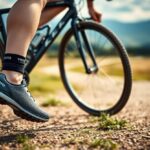
As you start running, you want to make sure you are doing it efficiently and safely. To achieve this, you need to focus on your stride and footwork. By making a few minor adjustments to your running form, you can reduce the risk of injury, improve your efficiency, and make running more enjoyable. Running light is all about proper technique, and with the right tips, you can learn to run lighter and more efficiently, even in barefoot shoes or minimalistic shoes.
The Benefits of Running Light
While running lighter can have a significant impact on your overall running experience, it’s necessary to understand the benefits it provides. Running lighter can make running more enjoyable, increase your efficiency, and reduce your risk of injury.
Improved Efficiency
Any runner can improve their efficiency by adopting a lighter running style. This can be achieved by making minor adjustments to your form, such as landing midfoot or forefoot, keeping your core engaged, and picking up your cadence. By doing so, you’ll be able to run with less effort and conserve energy.
Reduced Injury Risk
Behind every successful runner is a strategy to minimize the risk of injury. Running lighter can help you achieve this by reducing the impact on your joints and muscles. When you run lighter, you’re less likely to overstride, which can put excessive stress on your joints and lead to injuries.
Benefits of running lighter include reduced stress on your joints, improved running efficiency, and enhanced overall performance. By running in minimalistic shoes or barefoot shoes, you can improve your running form and reduce your risk of injury. Additionally, increasing your cadence and engaging your core can help you run lighter and more efficiently. With practice and patience, you can develop a lighter running style that will help you avoid common running injuries and achieve your running goals.
Using Sound to Improve Your Form
While running, the sound your feet make when they hit the ground tells you a lot about your running form. If you hear thuds or slapping noises, you’re “running heavy.” These sounds can indicate that you can improve your running form. Once you address your form, those sounds will not only go away, but you will improve your running efficiency.
Identifying “Heavy” Running
Besides the visual cues, the sound of your feet hitting the ground can help you identify if you’re running heavy. If you hear a loud thud or slapping noise, it may indicate that you’re overstriding or landing on your heel, which can increase your risk of injury and make your runs less efficient. By paying attention to the sound of your feet, you can make adjustments to your form and reduce your risk of injury.
Using Sound as Feedback
For instance, when you’re running, you can use the sound of your feet as feedback to adjust your form. If you hear a loud thud, you can try to land midfoot or forefoot instead of on your heel. This can help you run more efficiently and reduce the impact on your joints. By using the sound of your feet as feedback, you can make adjustments to your form and improve your overall running experience.
Even more importantly, using sound as feedback can help you develop a more efficient running technique. By paying attention to the sound of your feet, you can identify areas where you can improve your form and make adjustments to reduce your risk of injury. For example, if you hear a slapping noise, you can try to pick up your cadence and take quicker steps, which can help you run more efficiently and reduce the impact on your joints. Additionally, wearing minimalistic shoes or running barefoot can help you develop a more natural running technique and improve your overall running form. By combining these techniques, you can reduce your risk of injury and improve your overall running experience.

Tips for Running Lighter
If you want to improve your running efficiency and reduce injury risk, consider the following tips:
- Make sure your feet land under your body
- Land forefoot or midfoot
- Let your heels touch the ground
- Place and lift your foot off the ground as you run
- Use cues to help avoid plopping your feet
- Keep your core engaged
- Pick up your cadence
- Run barefoot, or in minimalistic shoes
Assume that implementing these tips will take time and practice to master.
Landing Under Your Body
Lightly landing with your foot too far in front of your body means you’re overstriding, which can increase forces on your joints and lead to injury. Instead, aim to have your feet land under your body.
Forefoot or Midfoot Strike
On the other hand, the type of footstrike is important for running lighter. Ideally, you want a forefoot or midfoot strike instead of a heel strike, as this allows you to use your legs as springs.
At the moment of landing, it’s vital to focus on proper footstrike and body positioning. When you land midfoot or forefoot, you’re using your legs as springs, starting with your feet. This helps to reduce the impact on your joints and makes your running more efficient. Running barefoot or in minimalistic shoes can also help you develop a more natural forefoot or midfoot strike, as they allow your feet to move naturally and provide less support, making you rely on your own muscles and tendons for stability. By focusing on proper footstrike and body positioning, you can improve your running efficiency, reduce your injury risk, and make your running feel more natural and efficient.
Refining Your Technique
All runners can improve their stride and footwork by making a few simple adjustments to their running form. You can start by paying attention to the sound of your feet hitting the ground, as this can provide valuable feedback on your technique. By making a few minor tweaks, you can improve your running efficiency and reduce your risk of injury.
Letting Your Heels Touch the Ground
Almost all runners can benefit from letting their heels touch the ground, as this allows you to use your Achilles tendon as a spring and gain “free energy” when it un-stretches. You can let your heel drop after landing on the ball or midfoot, and this will feel better or worse depending on the terrain and your pace.
Placing and Lifting Your Feet
Always think about “placing” your foot on the ground gently, rather than slamming it down, and then lifting it off the ground by flexing your hip. This will help you stay light on your feet and avoid overstriding.
To improve your foot placement and lifting, try to focus on lifting your knee or pulling your foot off the ground, rather than pushing your toes into the ground. This will help you use your hip flexor to lift your foot, rather than wasting energy by using your calf. By doing so, you can reduce your risk of injury and improve your running efficiency. Additionally, wearing minimalistic shoes or running barefoot can help you develop a more natural stride and improve your overall running form. Remember to listen to the sound of your feet and use it as feedback to adjust your technique. With practice, you can develop a lighter, more efficient stride that will help you run faster and farther with less effort.

Advanced Tips for Lighter Running
Not everyone is aware of the benefits of running lighter. To achieve this, consider the following tips:
- Use sound to know how “light” you’re running
- Make sure your feet land under your body
| Tip | Benefit |
|---|---|
| Land forefoot or midfoot | Reduces injury risk |
Using Cues to Avoid “Plopping”
Beneath the surface of proper running form lies the importance of using cues to avoid “plopping” your feet. By pretending to run on hot coals or eggshells, you can develop a lighter stride and reduce your risk of injury.
Keeping Your Core Engaged
Plopping into a run can be detrimental to your form, but keeping your core engaged can help. This means maintaining a gentle but consistent engagement of your abdominal muscles, which will help you run more efficiently and reduce your risk of injury.
Tips for keeping your core engaged include imagining lightly drawing your belly button towards your spine in a gentle, controlled manner. This should feel natural and sustainable throughout your run. By doing so, you’ll be able to maintain a consistent pace and avoid common running injuries. When you run in minimalistic shoes or barefoot shoes, you can improve your technique and reduce your risk of injury even further.
Optimizing Your Cadence and Footwear
Despite the importance of proper running form, many runners overlook the significance of cadence and footwear. You can improve your running efficiency and reduce injury risk by optimizing these factors.
Picking Up Your Cadence
At the core of efficient running is a well-tuned cadence. You can improve your running by increasing your steps per minute, which helps you stay light on your feet and avoid overstriding.
Running Barefoot or in Minimalist Shoes
For a more natural running experience, consider running barefoot or in minimalist shoes. You can improve your technique and strengthen your feet and legs by running in shoes that mimic the feeling of running barefoot.
With minimalist shoes, you can experience the benefits of barefoot running while still having protection for your feet. Barefoot shoes have a wider toe box, a non-elevated heel, and are lightweight, allowing your muscles, ligaments, and tendons to act as natural shock absorbers and springs. By running in minimalist shoes or barefoot, you can improve your posture and balance, reduce your risk of injury, and increase your overall running efficiency. As you run in barefoot shoes, you’ll notice that your feet and legs will become stronger over time, allowing you to run more efficiently and effectively.
Summing up
On the whole, you can improve your running stride and footwork by following simple tips. You will run lighter and more efficiently by making sure your feet land under your body, landing forefoot or midfoot, and letting your heels touch the ground. Using barefoot shoes or minimalist shoes can also help you achieve a better running form. By implementing these tips, you will reduce your injury risk and make running more fun.








Your insights on the importance of efficient running form really resonate with my own experiences as a runner, particularly concerning how minor adjustments can lead to significant improvements in both performance and enjoyment. I remember when I made the conscious choice to switch to a midfoot strike. Initially, it felt awkward, but over time, it became second nature and transformed my running experience.
It’s great to hear how switching to a midfoot strike changed your experience. It’s interesting how our bodies adapt; what feels awkward at first can transform into something that feels just right. Have you noticed any specific benefits, like reduced fatigue or fewer injuries, since making that change? I think a lot of runners don’t realize how tweaking just one aspect of their form can unlock a smoother, more enjoyable run. It’s like finding the sweet spot that suddenly makes everything click. What other adjustments have you explored to enhance your running?
It’s interesting how a simple adjustment like switching to a midfoot strike can completely change the game for so many runners. I get what you’re saying about that initial awkwardness; it’s like trying on a new pair of shoes that just doesn’t feel right at first. But once you give it a bit of time, your body starts to adapt. It’s almost like your legs and feet have a conversation, figuring out how to work together better.
I appreciate your insights into the importance of running form and the benefits of adopting a lighter running style. However, while the focus on midfoot and forefoot landing is crucial, I wonder if we might oversimplify the topic when it comes to individual variations in body mechanics. Not every runner will find that these adjustments lead to a more efficient style; for some, traditional heel striking has been a part of their running identity and has worked fine.
Your emphasis on running light is an important consideration that often gets overlooked in the running community. I’ve experienced firsthand how minor adjustments to running form can yield significant benefits. For instance, after shifting to a midfoot strike, I noticed less strain on my knees during longer runs, which had previously been a source of discomfort.
I really resonate with your emphasis on running form and the importance of landing midfoot or forefoot. I’ve noticed a significant difference in my own runs since I started focusing on these adjustments. It not only made each mile feel lighter but also helped me to enjoy the experience much more, especially when running on varied terrains.
It’s great to hear that you’ve found such a positive shift in your running experience by focusing on your form. I’ve had a similar journey where paying attention to my foot strike truly changed how I feel on runs. Transitioning to a midfoot or forefoot landing not only alleviated some minor aches I was having but also made me a lot more mindful of my overall posture and stride.
It’s great to hear how much of a difference focusing on your form has made for you. Running can really become a different experience when you tune in to how your body interacts with the ground. The midfoot and forefoot strikes can create a smoother rhythm, especially on varied terrains, as you’ve noticed.
I really resonate with your emphasis on running light and efficient! I remember when I first transitioned to barefoot running shoes; it felt so different, but focusing on my stride made a huge difference. I started incorporating midfoot landings and engaging my core more, and it’s fascinating how those slight tweaks transformed my run.
Your insights on running light really resonate with me. I’ve been experimenting with my running form recently, and adopting a midfoot landing has drastically improved my comfort and efficiency. It’s fascinating how such minor adjustments can yield significant benefits—not just for performance, but also for enjoyment.
Your insights on running light resonate deeply with my own experiences on the trail. I’ve found that focusing on my form has not only transformed my efficiency but also unlocked a new joy in my runs. It reminds me of how crucial it is to connect with our bodies and the ground beneath us. I’ve shifted to forefoot striking, and I can truly feel the difference—it feels almost like dancing with the pavement.
Your insights on running light really resonate with me! When I first started running, I didn’t pay much attention to my form, and I experienced a fair share of setbacks from injuries. It wasn’t until I shifted to a more midfoot landing that I started to feel the difference—not just in my stride but also in my overall enjoyment of running. I’ve found that even small tweaks like engaging my core and adjusting my cadence can lead to significant improvements.
It’s great to hear how your running journey has evolved. That adjustment to a midfoot landing can make a surprising difference. It’s interesting how much our form can influence not just our performance but also our overall experience and enjoyment of running. When we start out, it’s easy to get caught up in the excitement of just being out there, sometimes at the expense of good technique. But those early setbacks can truly serve as valuable learning experiences.
Your insights on running light really resonate with me. I’ve found that focusing on my footwork has not only helped me enjoy my runs more, but it has also made a noticeable difference in how I feel afterward. Transitioning to midfoot striking allowed me to feel more connected to the ground, which surprisingly gave me a sense of freedom.
Ah, the art of running light! It’s like discovering that your shoes have secret wings, except, of course, they don’t make you look like you’re auditioning for a circus; they just make you feel like you’re gliding. I often think that running is a bit like dance—an intricate ballet where one wrong step can turn into a not-so-graceful tumble or, in my case, a “why did I just trip over my own foot?” moment.
It’s fascinating to see how a focus on running technique can really transform the experience! I remember when I first switched to a more minimalistic shoe—I was surprised by how much of a difference it made in my form and comfort. At first, I struggled with landing on my midfoot, but with practice, it felt so much more natural.
I appreciate your insights into the importance of running efficiently and safely. The focus on stride and footwork resonates deeply, especially as someone who has experienced the impacts of poor running form firsthand. When I first transitioned to running, I tended to favor a heel strike, which not only hampered my over-all performance but also led to persistent knee pain. It wasn’t until I started paying attention to landing midfoot and actively engaging my core that I noticed marked improvements in both my running experience and my enjoyment of the activity itself.
Your discussion on running light resonates with me, especially as I’ve been experimenting with different running styles to improve my form. I’ve noticed that my efficiency has significantly improved since I started focusing on my footwork and engaging my core, just as you suggested.